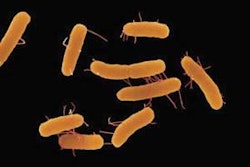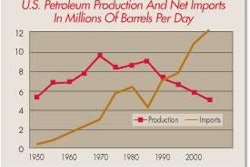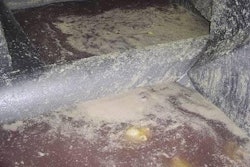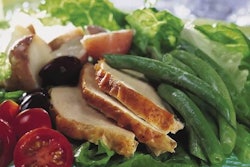.jpg?auto=format%2Ccompress&q=70&w=400)
U.S. Poultry & Egg Association recently honored three broiler processing plants with 2007 Clean Water Awards recognizing superior performance and commitment to environmental stewardship. Simmons Foods, Southwest City, Mo.; Tyson Foods, Noel, Mo.; and Tyson Foods, Corydon, Ind., share outstanding records of compliance to environmental regulations and a commitment to being good neighbors in their respective communities.
These plants have not always had perfect records of compliance and the staffs at each facility have worked hard to improve their systems to reach the outstanding levels of performance each has attained. A willingness to embrace innovation and implement new technologies coupled with lots of training and a commitment to doing the best job possible has allowed each of these award winning plants to make the most of their second chance to excel.
Simmons Foods: The Chairman's Marching Orders
Whether it's discharging the cleanest wastewater possible or retrieving nutrients from the waste stream at a profit, Simmons Foods excels.
Part of the reason that the Simmons Foods, Southwest City, Mo., plant's environmental programs and wastewater treatment system are as good as they are today is the result of the struggles that the plant had in its past. This plant had "issues" in the 1990s, and Mark Simmons, chairman of Simmons Foods, said, "We are as good as we are now, because we are never going back to living the way we did back then."
The original processing plant at Southwest City was built in 1967, and Simmons Foods purchased the facility in 1982. Over the years, the plant has essentially been rebuilt, and little of the original structure remains. Now, Simmons slaughters and debones 420,000 head of 4.5-pound broilers daily and renders 2,000 tons per day at the site. The rendering plant is the fourth largest in the USA, and it processes offal from 13 broiler and turkey plants in three states. Simmons also operates its PRO*CAL plant at this site. PRO*CAL is the brand name for a feed ingredient produced from nutrients recovered from the waste stream of poultry plants.
Around 1.8 million gallons of effluent from the processing facilities at Southwest City are fully treated every day and discharged to an unnamed tributary of Honey Creek, which ultimately flows into Grand Lake. The facility's permit requirements for its effluent are among the most restrictive in the industry. For example, daily phosphorous concentration is limited to 1.0 milograms per liter, and the monthly average is 0.5 milograms per liter. But even with these tight limits, the plant has operated for seven years without a violation of any kind.
Mark Simmons' marching orders to the wastewater treatment plant staff are pretty simple, "Make the best water that you can, don't just make the regulatory limits," he said. This message has been taken to heart, and the results of their efforts have been consistently outstanding. In 2006, the plant produced effluent that contained only 25 percent of the allowable phosphorous level. Some other measured compounds were reduced to less than 5 percent of their allowable levels.
Simmons Foods takes all aspects of environmental compliance very seriously. Senior management is e-mailed copies of the daily wastewater reports, and Mark Simmons looks at the wastewater reports every day. He even checks the results on his blackberry when he travels. Besides the chemical testing that the Simmons Foods environmental staff performs, Mark Simmons said that he has one final quality control check that he makes himself. "I keep my boat at the Grand Lake Sailing Club in Diller Cove, which is in the Honey Creek arm of the Grand Lake." The effluent from the Simmons Foods wastewater treatment plant flows into Honey Creek, so each trip out on the sail boat starts as a quality control check on wastewater quality. Mark Simmons is proud to point out that in the government-sponsored studies of water quality in Grand Lake, the Honey Creek arm has the best water quality of the entire lake.
Besides his love of sailing, Mark Simmons said that there is a practical explanation for his company's strong commitment to environmental protection at Southwest City. He said that he wants to be able to stay in the poultry processing and rendering businesses for a long time, and ultimately, being out of compliance means being out of business. Looking down the road, he saw odor control as the next major environmental hurdle for renderers. So, when Simmons Foods' staff designed the company's PRO*CAL operation, they went to Europe to view the best available technology for controlling rendering odors.
Rendering plants use heat to kill microorganisms in the offal and to dry it by "cooking out" moisture. The steam cooked off in the rendering process also contains other volatile substances in addition to water vapor which can give the exhaust an unpleasant smell. Typically, rendering plants use water to cool the exhaust and condense the steam. Many of the odor causing volatile compounds condense along with the water vapor, and the condensate must be treated to remove these compounds.
In Europe, the Simmons staff found that thermal oxidizers offer an alternative to traditional rendering systems. A thermal oxidizer has a large gas-fired burner which mixes outside air along with the air cooked off the rendered product. The gas combustion chamber reaches 1500 F, and at this temperature the volatile compounds in the rendering exhaust are oxidized. The hot gases go through the heat exchanger of the boiler on their way out the "smoke stack." At the heat exchanger, heat from combustion gases heats water to produce steam which is used to power the cookers in the rendering plant. Using a thermal oxidizer eliminates the need for condensers in rendering and the need to treat condensate in the wastewater treatment system. Instead of having to treat water to remove the volatile compounds, these compounds become fuel in the thermal oxidizer.
Using a thermal oxidizer only reduces boiler efficiency by around 1 percent or 2 percent. The thermal oxidizers used at the Simmons plant are manufactured by Babcock-Wanson in Italy and cost $2 million each. These thermal oxidizers are the first in use in the USA, and Simmons has one at the PRO*CAL plant and two at the rendering plant.
Untreated poultry wastewater is loaded with valuable nutrients; the problem is how to economically retrieve these nutrients so that they can be put to good use. Simmons has come up with a product, PRO*CAL, which upgrades dissolved air flotation (DAF) skimmings that were previously land applied into a revenue generating feed ingredient. DAF skimmings from the Southwest City and other plants are combined with poultry blood and other components in a patented process to manufacture PRO*CAL. Novus International is marketing PRO*CAL for Simmons, and this product is high in energy and high in protein. PRO*CAL is particularly valuable for feeding to dairy cattle because it has inert fat and bypass protein. Bypass means that the nutrients are not altered by rumen microbes and are available to the cow for absorption in the small intestines. Bypass nutrients are of particular value to dairy cows in high milk production. PRO*CAL is also being marketed as a feed ingredient for poultry, swine, cattle and for use in aquaculture. PRO*CAL is priced based on the value of comparable feed ingredients and currently sells for around $500 per ton. Simmons Foods has invested $10 million in the PRO*CAL plant and can produce 15,000 to 17,000 tons of product annually.
Simmons Foods Southwest City plant does a great job treating wastewater, but it also does a remarkable job conserving water. Water conservation and reuse programs have been so effective that the broiler processing plant routinely uses 4.0 gallons of water per bird.
Simmons Foods was selected as the 2007 Clean Water Award winner in the full-treatment category.
Tyson's Noel Plant: Fitting In With The Tourists
Since acquiring the Noel plant a decade ago, Tyson has cut water usage, reduced sludge and turned chicken fat into feed.
The Tyson Foods plant in Noel, Mo., discharges 1.25 million gallons of treated effluent into the Elk River every day. One neighbor of the Tyson Foods plant in Noel is a canoeing excursion and camping site on the shore of the Elk River. Natural beauty, outdoor activities and proximity to Branson, Mo., all make tourism an important industry in the Noel area.
The broiler plant in Noel became a Tyson Foods plant when the company acquired Hudson Foods in 1998. Shortly after the acquisition, the plant had EPA issues and went under a consent decree in 2001. Since that time, the Tyson staff at Noel has made great strides and has turned the plant's wastewater treatment and environmental programs around.
The Noel plant processes 260,000 head of 6.1-pound broilers per day. Production at the plant is done almost exclusively for Wal-Mart and Sam's Club stores, and product consists of net-weight, traypack items and whole birds. Cut-up parts are singulated, weighed and accumulated by a batch weighing system. Meyn cut-up lines and breast deboning equipment are employed, and the plant has 14 Ossid over-wrap machines.
Total plant water usage has been reduced by around 50 percent in the last five years. Water usage has been cut from 10.2 gallons per bird in 2002 down to 4.2 gallons per bird today as a result of water conservation and water reuse.
The Noel complex instituted an environmental management system (EMS) in 2004. The EMS addresses all of the environmental impacts of the company's operations, not just wastewater treatment. Several innovations have been designed and implemented at the Noel plant to make better use of resources. Working with H2O Tech, Ozark, Mo., the Noel plant staff implemented two technologies that have allowed it to reduce the volume of sludge that must be land applied and to recapture some of the nutrients from these biosolids.
A tri-canter system was installed in 2003 to remove chicken fat from the wastewater at the DAF. This fat is recycled at the company's feed mill back into broiler rations. The tri-canter system has allowed the Noel facility to reuse over 1 million pounds of poultry fat at its feed mill and has significantly reduced the amount of DAF skimmings that are land applied. This operation has saved the company money in disposal costs and in feed ingredient purchases. Land application of DAF skimmings has been reduced by over 30 million pounds annually.
The plant installed a sludge press in November of 2006, and it can handle 60 gallons per minute of biosolids flow from the clarifier. This press is also used to remove water from the sludge in the old lagoons. The sludge dewatering system increases the solids in the sludge from 2 percent to 12 percent, and it greatly reduces the amount of sludge that needs to be land applied.
With its EMS in place and the company's commitment to environmental protection clearly understood, the Noel plant has established an enviable record of compliance with a very strict permit. This plant has come a long way in a relatively short period of time, and it was named the runner-up in the full-treatment category.
Tyson's Corydon Plant: Your Best Neighbor
This Tyson plant in southern Indiana says it wants to be your best neighbor.'
The Tyson Foods plant in Corydon, Ind., is right in the heart of "downtown." Corydon, which was the original state capital of Indiana, is a picturesque town in Southern Indiana not far from the Ohio River, not far across the river from Louisville, Ky. The Corydon plant is bordered by a golf course on one side, the protected Indian Creek on another side and overlooked by a subdivision on the hill.
David Whittington, manager of the Corydon complex, said, "Our motto is, We want to be your best neighbor.'" But years ago, this plant wasn't always the best of neighbors.
The Corydon plant began its life as a Ralston Purina plant and was later purchased by Hudson Foods. Tyson acquired the plant in 1998 as part of its purchase of Hudson Foods, and Tyson has since invested $25 million dollars in the complex.
The Corydon plant pre-treats its wastewater prior to discharging to the municipal wastewater treatment system (POTW), and the plant represents about half of the POTW's flow on a daily basis. In the 1990s, the town's POTW was given an ammonia limit, and it struggled to meet the new limit. Hudson redesigned the processing plants treatment system adding an equalization (EQ) basin with biological treatment in the EQ basin. This biological treatment was designed to denitrify the wastewater prior to discharge to the POTW. Unfortunately, the Corydon plant staff had trouble making the new system work, and the EQ basin was located at the base of the hill which has a subdivision on top of it. Because the hill is so steep and the houses are so close, some of the "neighbors" can actually look down into the EQ basin, and they can certainly smell it if things aren't working properly. The neighbors were not happy, and the POTW still had trouble making its limits. Relations with the town were not good at that point.
Lots of training for the wastewater treatment staff, some tweaking of the treatment system, and attention to detail have turned things around for the Corydon plant. When operated properly, this pretreatment system has reduced the load going to the POTW to the point that it no longer has any problems complying with its own permit. All surcharges have been eliminated, and the plant is now always in compliance. In addition to improving the quality of its effluent, Tyson has also dramatically decreased the amount of water that it sends to the POTW every day.
Tyson Corydon processes 130,000 head of 3.9-pound broilers per day. These birds are used to make cut-up, batter-breaded, par-fried parts; rotisserie whole birds; and fast-food cut-up birds. Most of the plant's products go to retail deli operations in Wal-Mart and other supermarkets. Product is sized out of the chiller and is either cut-up, marinated as a whole bird, or cut-up batter breaded and par fried.
The plant has cut its water usage almost in half from well over 800,000 gallons per day to around 480,000 gallons per day. Currently, water usage stands at just 3.7 gallons per bird. In addition to water conservation measures employed at the plant, a water reuse system is in operation. Water is collected at the bird washer, and that water is screened and chlorinated so that it can be reused elsewhere in the evisceration department. Reducing water usage has reduced the water and sewer bills for the plant and has also reduced the usage of chemicals and energy in the wastewater area.
The Corydon plant was selected as winner of the pretreatment award.


















